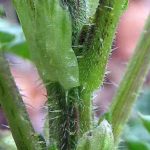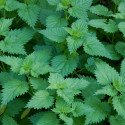My favorite medicinal herb is Stinging Nettle (Urtica dioica).* It has many uses for health and wellness, and loves to impart its versatility as a cooking recipe ingredient!
Here are the basics when getting to know Stinging Nettle:
Historical:
- “The sting of the Nettle is but nothing compared to the pains that it heals” from Lelord Kordels’ “Natural Folk Remedies”
- Earliest uses of the plant were for cloth during the Bronze Age. Using the plant fibers was common again during WWI when the Germans were stretching their cotton supply.
- The leaves are so high in chlorophyll that the Brits used it to make green dye for WWII camo paint.
- It is believed that the plant was brought to the U.S. intentionally because of its medicinal importance.
Plant Facts:
- A member of the mint family – you can tell by its square stalk
- There are approximately 45 nettle species worldwide.
- Prefers shady areas and disturbed soil; a nitrogen-giver like alder & scotch broom. They thrive in areas with abundant rainfall.
- Dies back to dried stalk in late fall, then begins springing up in early spring.
- Flowers are at the very crown of the stalk & topmost leaf pair; they are very tiny white blooms.
- Planted amidst other herbs as a companion plant it stimulates plant growth and increases essential oils content.

Stinging Nettle Hairs - Small, hollow hairs , or ‘needles’, on the stems & underside of the leaves are filled with formic acid which causes the stinging action. The plant’s name comes from the Anglo-Saxon word for ‘needle’.
- Nettle’s own juice and that of mullein, will act as an antidote to a nettle sting.
- Stalks can be made into a very strong twine
Medicinal Qualities & Uses:
- The medicinal value lies primarily in the leaves; roots are used but less frequently.
- A fabulous spring tonic for entire system, especially the liver & kidneys. Seventeenth-century herbalist Nicholas Culpepper wrote that eating nettles “consumes the phlegmatic superfluities which winter has left behind.”
- Anti-inflammatory
- Blood purifier & builder. Also staunches blood flow, i.e. a nosebleed and internal bleeding.
- Rich in: iron, silicon, potassium, phosphorous, protein, calcium & alkaloids which neutralize uric acid therefore making it a great aid for rheumatism. Also contains potent levels of Vits A, C & D.
- High in histamine content which accounts for its great help w/ allergy symptoms
- Nerve tonic: very helpful when kicking tobacco addiction.
- Alopecia (hair loss)
- Oily skin & hair
- Prostate problems (root of the plant is used)
- Itchy skin due to insect bites
- Rids the body of worms
- Stops diarrhea
- Stinging action is destroyed by breaking the hairs, ie. in a blender or food processor and when heated (i.e. cooked)
CULINARY USES:
- Use like spinach in soups, sautés, stir-fries or casseroles.
- Infuse leaves in boiling water for 10 minutes and drink as a tea. It also blends well with other herbs as it does in Breathe Better Tea.
- Make pesto!
No matter how you use this wonderful plant, you will be blessed by at least one of its gifts.
*SAFETY: The freeze-dried form is contraindicated for pregnancy.
Feature image by Heather Michet; photo of Stinging Nettle Hairs by PhotoBucket
